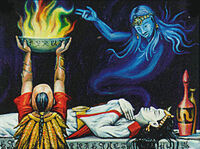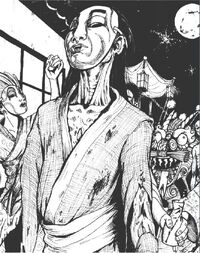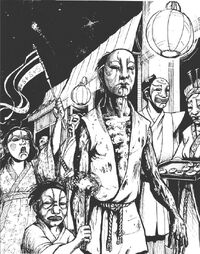No edit summary |
|||
| Line 4: | Line 4: | ||
== Nature of the Festival == |
== Nature of the Festival == |
||
| − | During the [[festival]], a family's ancestors, as well as the malevolent spirits of those who met violent ends or who had no grave, returned to the homes of their descendants. Extended families came together across [[Rokugan]] at this time and provided two sets of altars for the [[spirit]]s: one for the ancestors of their family and one for the spirits of those with no remaining family to provide an altar for them. <ref name="Phoenix30">''Way of the Phoenix'', p. 30</ref> It was celebrated in the [[Month of the Dog]]. <ref>''Winter Court: Kyuden Seppun'', p. 62</ref> |
+ | During the [[festival]], in the last day of the [[month of the Dog]], <ref name="WCKS67">''Winter Court: Kyuden Seppun'', p. 67</ref> a family's ancestors, as well as the malevolent spirits of those who met violent ends or who had no grave, returned to the homes of their descendants. Extended families came together across [[Rokugan]] at this time and provided two sets of altars for the [[spirit]]s: one for the ancestors of their family and one for the spirits of those with no remaining family to provide an altar for them. <ref name="Phoenix30">''Way of the Phoenix'', p. 30</ref> It was celebrated in the [[Month of the Dog]]. <ref>''Winter Court: Kyuden Seppun'', p. 62</ref> |
== Parade of the Dead == |
== Parade of the Dead == |
||
| Line 10: | Line 10: | ||
Rokugani traveled to the graves where their ancestors were interred, light lanterns to greet their spirits, and then returned to their homes, hanging the lanters outside to guide the spirits to them. That night, the local [[shugenja]] would perform a Bon dance to entertain the gathered spirits, preventing them from becoming angry and harming people. The shugenja would travel from house to house, so they could dance for every local family. <ref name="Phoenix30"/> |
Rokugani traveled to the graves where their ancestors were interred, light lanterns to greet their spirits, and then returned to their homes, hanging the lanters outside to guide the spirits to them. That night, the local [[shugenja]] would perform a Bon dance to entertain the gathered spirits, preventing them from becoming angry and harming people. The shugenja would travel from house to house, so they could dance for every local family. <ref name="Phoenix30"/> |
||
| − | The streets were filled with representations of the [[Kami|Great Kami]], the [[Dragon]]s of Myth, and white-faced ‘[[ghost]]s’ and [[spirit]]s of the past. The Bon Festival was a time when the dead souls of the past were closest to their heirs in the world. <ref name="NoaTS6">''Night of a Thousand Screams'', p. 6</ref> The celebration was known as the ''Parade of the Dead". <ref>''Night of a Thousand Screams'', p. 41</ref> |
+ | The streets were filled with representations of the [[Kami|Great Kami]], the [[Dragon]]s of Myth, and white-faced ‘[[ghost]]s’ and [[spirit]]s of the past. The Bon Festival was a time when the dead souls of the past were closest to their heirs in the world. <ref name="NoaTS6">''Night of a Thousand Screams'', p. 6</ref> The celebration was known as the ''Parade of the Dead". <ref>''Night of a Thousand Screams'', p. 41</ref>'' |
During the festival, there were [[fireworks]], parades, music, traditional dances, and long twisting streamers. Cakes made of bleached white rice and covered in brown sugar were made to remind people that death (symbolized by the white) was a part of all life. <ref name="NoaTS6"/> |
During the festival, there were [[fireworks]], parades, music, traditional dances, and long twisting streamers. Cakes made of bleached white rice and covered in brown sugar were made to remind people that death (symbolized by the white) was a part of all life. <ref name="NoaTS6"/> |
||
Revision as of 21:32, 16 March 2012

Bon Festival
The Bon Festival was a festival of remembrance and reverence towards a family's departed ancestors.
Nature of the Festival
During the festival, in the last day of the month of the Dog, [1] a family's ancestors, as well as the malevolent spirits of those who met violent ends or who had no grave, returned to the homes of their descendants. Extended families came together across Rokugan at this time and provided two sets of altars for the spirits: one for the ancestors of their family and one for the spirits of those with no remaining family to provide an altar for them. [2] It was celebrated in the Month of the Dog. [3]
Parade of the Dead

Bon Festival at Ryoko Owari
Rokugani traveled to the graves where their ancestors were interred, light lanterns to greet their spirits, and then returned to their homes, hanging the lanters outside to guide the spirits to them. That night, the local shugenja would perform a Bon dance to entertain the gathered spirits, preventing them from becoming angry and harming people. The shugenja would travel from house to house, so they could dance for every local family. [2]
The streets were filled with representations of the Great Kami, the Dragons of Myth, and white-faced ‘ghosts’ and spirits of the past. The Bon Festival was a time when the dead souls of the past were closest to their heirs in the world. [4] The celebration was known as the Parade of the Dead". [5]
During the festival, there were fireworks, parades, music, traditional dances, and long twisting streamers. Cakes made of bleached white rice and covered in brown sugar were made to remind people that death (symbolized by the white) was a part of all life. [4]
At the end of the festival, the people sent the spirits back to the worlds beyond. The people guided the spirits by floating lit candles and paper lanterns down nearby rivers [2] in the called Paper Lantern Festival. [6]
External Links

Bon Festival at Ryoko Owari
- Bon Festival (Imperial)